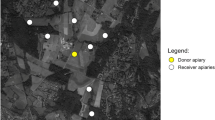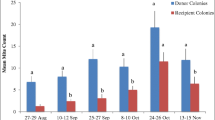Abstract
We performed two experiments to study the hiding behavior of various beetles introduced into colonies of European honey bees, Apis mellifera L. In the first experiment, we studied the spatial distribution within confinement sites of six beetle species at eight time intervals following their introduction into honey bee observation hives. For each beetle species, we also determined whether the beetle’s level of integration into honey bee colonies correlated with its ability to hide at confinement sites within colonies. In experiment 1, we used five species of nitidulid beetles and one species of tenebrionid beetle, collectively representing three differing levels of integration into honey bee colonies. These species (and their level of integration) included Aethina tumida (highly integrated), Lobiopa insularis, and Epuraea luteola (accidentals), and Carpophilus humeralis, C. hemipterus, and Tribolium castaneum (non-integrated). There were always more A. tumida found in confinement sites than beetles of the other species. This difference became more pronounced over the 24-h observation period. In experiment 2, we determined whether previous A. tumida occupation of confinement sites predisposed those sites to hosting invading A. tumida never before exposed to honey bee colonies. The results from this study indicate that invading A. tumida find hiding sites within honey bee colonies more rapidly if other A. tumida previously occupied the confinement sites. Collectively, these studies suggest that A. tumida is unique among beetle invaders with respect to its ability to seek out and occupy confinement sites inside honey bee colonies.




Similar content being viewed by others
References
Atkinson E.B. and Ellis J.D. 2011. Adaptive behaviour of honeybees (Apis mellifera) toward beetle invaders exhibiting various levels of colony integration. Physiol. Entomol. doi:10.1111/j.1365-3032.2010.00774.x
Bartelt R.J., Dowd P.F. and Plattner R.D. 1991. Aggregation pheromone of Carpophilus lugubris - new pest-management tools for the nitidulid beetles. Acs Symposium Series 449: 27-40
Bartelt R.J., Dowd P.F., Vetter R.S., Shorey H.H. and Baker T.C. 1992. Responses of Carpophilus hemipterus (Coleoptera: Nitidulidae) and other sap beetles to the pheromone of C. hemipterus and host-related coattractant in California field-tests. Environ. Entomol. 21: 1143-1153
Bartelt R.J., Vetter R.S., Carlson D.G. and Baker T.C. 1994. Responses to aggregation pheromones for 5 Carpophilus species (Coleoptera: Nitidulidae) in a California date garden. Environ. Entomol. 23: 1534-1543
Bartelt R.J., Weaver D.K. and Arbogast R.T. 1995. Aggregation pheromone of Carpophilus dimidiatus (F.) (Coleoptera: Nitidulidae) and responses to Carpophilus pheromones in South Carolina. J. Chem. Ecol. 21: 1763-1779
Bartelt R.J., Kyhl J.F., Ambourn A.K., Juzwik J. and Seybold S.J. 2004. Male-produced aggregation pheromone of Carpophilus sayi, a nitidulid vector of oak wilt disease, and pheromonal comparison with Carpophilus lugubris. Agr. Forest. Entomol. 6: 39-46
Breed M.D., Guzman-Novoa E. and Hunt G.J. 2004. Defensive behavior of honey bees: Organization, genetics, and comparisons with other bees. Annu. Rev. Entomol. 49: 271-298. doi:10.1146/annurev.ento.49.061802.123155
Cosse A.A. and Bartelt R.J. 2000. Male-produced aggregation pheromone of Colopterus truncatus: Structure, electrophysiological, and behavioral activity. J. Chem. Ecol. 26: 1735-1748
Dowd P.F. and Bartelt R.J. 1993. Aggregation pheromone glands of Carpophilus freemani (Coleoptera: Nitidulidae) and gland distribution among other sap beetles. Ann. Entomol. Soc. Am. 86: 464-469
Ellis J.D. 2005. Reviewing the confinement of small hive beetles (Aethina tumida) by western honey bees (Apis mellifera). Bee World 86: 56-62
Ellis J.D. and Hepburn H.R. 2006. An ecological digest of the small hive beetle (Aethina tumida), a symbiont in honey bee colonies (Apis mellifera). Insect. Soc. 53: 8-19. doi:10.1007/s00040-005-0851-8
Ellis J.D., Neumann P., Hepburn R. and Elzen P.J. 2002a. Longevity and reproductive success of Aethina tumida (Coleoptera: Nitidulidae) fed different natural diets. J. Econ. Entomol. 95: 902-907
Ellis J.D., Pirk C.W.W., Hepburn H.R., Kastberger G. and Elzen P.J. 2002b. Small hive beetles survive in honeybee prisons by behavioural mimicry. Naturwissenschaften 89: 326-328. doi:10.1007/s00114-002-0326-y
Ellis J.D., Hepburn H.R., Ellis A.M. and Elzen P.J. 2003. Social encapsulation of the small hive beetle (Aethina tumida Murray) by European honeybees (Apis mellifera L.). Insect. Soc. 50: 286-291. doi:10.1007/s00040-003-0671-7
Ellis J.D., Delaplane K.S., Cline A. and McHugh J.V. 2008. The association of multiple sap beetle species (Coleoptera: Nitidulidae) with western honey bee (Apis mellifera) colonies in North America. J. Apicult. Res. 47: 188-189. doi:10.3827/ibra.1.47.3.04
Ellis J.D., Spiewok S., Delaplane K.S., Buchholz S., Neumann P. and Tedders W.L. 2010. Susceptibility of Aethina tumida (Coleoptera: Nitidulidae) larvae and pupae to entomopathogenic nematodes. J. Econ. Entomol. 103: 1-9. doi:10.1603/ec08384
Elzen P.J., Baxter J.R., Neumann P., Solbrig A., Pirk C., Hepburn H.R., Westervelt D. and Randall C. 2001. Behaviour of African and European subspecies of Apis mellifera toward the small hive beetle, Aethina tumida. J. Apicult. Res. 40: 40-41
Haddad N., Esser J. and Neumann P. 2008. Association of Cryptophagus hexagonalis (Coleoptera: Cryptophagidae) with honey bee colonies (Apis mellifera). J. Apicult. Res. 47: 190-191
Hassan A.R. and Neumann P. 2008. A survey for the small hive beetle in Egypt. J. Apicult. Res. 47: 186-187
Hood W.M. 2000. Overview of the small hive beetle, Aethina tumida, in North America. Bee World 81: 129-137
JMP, Version 8 2008. SAS Institute, Inc. Cary, North Carolina
Moore J. 1995. The behavior of parasitized animals. Bioscience 45: 89-96
Nardi J.B., Dowd P.F. and Bartelt R.J. 1996. Fine structure of cells specialized for secretion of aggregation pheromone in a nitidulid beetle Carpophilus freemani (Coleoptera: Nitidulidae). Tissue Cell 28: 43-52
Neumann P. and Elzen P.J. 2004. The biology of the small hive beetle (Aethina tumida, Coleoptera: Nitidulidae): Gaps in our knowledge of an invasive species. Apidologie 35: 229-247. doi:10.1051/apido:2004010
Neumann P. and Ritter W. 2004. A scientific note on the association of Cychramus luteus (Coleoptera: Nitidulidae) with honeybee (Apis mellifera) colonies. Apidologie 35: 665-666. doi:10.1051/apido:2004051
Neumann P., Pirk C.W.W., Hepburn H.R., Solbrig A.J., Ratnieks F.L.W., Elzen P.J. and Baxter J.R. 2001. Social encapsulation of beetle parasites by Cape honeybee colonies (Apis mellifera capensis Esch.). Naturwissenschaften 88: 214-216
Parsons C.T. 1943. A revision of Nearctic Nitidulidae (Coleoptera). Bull. Mus. Comp. Zool. Harvard Coll. 92: 121-278
Peng C.W. and Williams R.N. 1990. Multiple-species rearing diet for sap beetles (Coleoptera: Nitidulidae). Ann. Entomol. Soc. Am. 83: 1155-1157
Pettis J.S. and Shimanuki H. 2000. Observations on the small hive beetle, Aethina tumida Murray, in the United States. Am. Bee. J. 140: 152-155
Sakofski F. 1990. Quantitative investigations on transfer of Varroa jacobsoni Oud. In: Proc. Int. Symp. on Recent Research on Bee Pathology (Ritter W., Ed), International Federation of Beekeepers Association, Gent, Belgium. pp 70-72
Schmid-Hempel P. 1995. Parasites and social insects. Apidologie 26: 255-271
Schmid-Hempel P. 1998. Parasites in Social Insects. Princeton University Press, Princeton, New Jersey, pp 392
Smith J.B. 1886. Ants’ nests and their inhabitants. Am. Nat. 20: 679-687
Suazo A., Torto B., Teal P.E.A. and Tumlinson J.H. 2003. Response of the small hive beetle (Aethina tumida) to honey bee (Apis mellifera) and beehive-produced volatiles. Apidologie 34: 525-533. doi:10.1051/apido:2003043
Torto B., Suazo A., Alborn H., Tumlinson J.H. and Teal P.E.A. 2005. Response of the small hive beetle (Aethina tumida) to a blend of chemicals identified from honeybee (Apis mellifera) volatiles. Apidologie 36: 523-532. doi:10.1051/apido:2005038
Torto B., Boucias D.G., Arbogast R.T., Tumlinson J.H. and Teal P.E.A. 2007. Multitrophic interaction facilitates parasite–host relationship between an invasive beetle and the honey bee. Proc. Natl. Acad. Sci. USA 104: 8374-8378. doi:10.1073/pnas.0702813104
Whitfield C.W., Behura S.K., Berlocher S.H., Clark A.G., Johnston J.S., Sheppard W.S., Smith D.R., Suarez A.V., Weaver D. and Tsutsui N.D. 2006. Thrice out of Africa: Ancient and recent expansions of the honey bee, Apis mellifera. Science 314: 642-645. doi:10.1126/science.1132772
Williams R.N., Fickle D.S., Bartelt R.J. and Dowd P.F. 1993. Responses by adult Nitidulidae (Coleoptera) to synthetic aggregation pheromones, a coattractant, and effects of trap design and placement. Eur. J. Entomol. 90: 287-294
Acknowledgments
We thank Catherine Zettel Nalen for reviewing initial drafts of the manuscript and Jane Medley for creating the observation hive diagram (both of the University of Florida). Also, we thank the members of the Chemistry Research Unit at the USDA-ARS for providing Aethina tumida and Tribolium castaneum.
Author information
Authors and Affiliations
Corresponding author
Rights and permissions
About this article
Cite this article
Atkinson, E.B., Ellis, J.D. Honey bee, Apis mellifera L., confinement behavior toward beetle invaders. Insect. Soc. 58, 495–503 (2011). https://doi.org/10.1007/s00040-011-0169-7
Received:
Revised:
Accepted:
Published:
Issue Date:
DOI: https://doi.org/10.1007/s00040-011-0169-7




